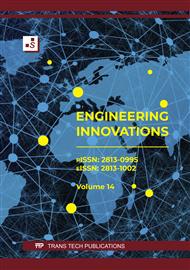[1]
Shahadahtul, N. Dullah, S. Ayog, J. Amaludin, A, Mechanical properties of concrete using eggshell ash and rice husk ash as partial replacement of cement. MATEC Web of Conferences. 103 (2017), 01001.
DOI: 10.1051/matecconf/201710301002
Google Scholar
[2]
Amaludin, H. A. Lim, C. H. Baharum, A, Mechanical properties of concrete using eggshell ash and rice husk ash as partial replacement of cement. MATEC Web of Conferences. 103 (2016), 01002.
DOI: 10.1051/matecconf/201710301002
Google Scholar
[3]
Omprakash, K. Chandra, K. J. Balakrishna, B. B, An experimental study on strength properties of concrete using GGBS, rice husk ash (RHA) and egg shell powder (ESP). International Journal of Scientific Research and Review. 7 (2018).
Google Scholar
[4]
Manzoor, A. A. Anand, E, Behaviour of concrete containing egg shell powder as cement replacing material. International Journal of Scientific Development and Research. (2018).
Google Scholar
[5]
Nisar, A. G. Fareed, A. M. Mian, J. Zaheer, H. Z, Analysis of eggshell powder as a partial replacing material in concrete. International Journal of Modern Research in Engineering & Management (2019).
Google Scholar
[6]
Salas, D. A. Ramirez, A. D. Rodríguez, C. R. Petroche, D. M. Boero, A. J. Duque-rivera, J, Environmental impacts, life cycle assessment and potential improvement measures for cement production: a literature review. Journal of Cleaner Production. 113 (2016), 114-122.
DOI: 10.1016/j.jclepro.2015.11.078
Google Scholar
[7]
Imbabi, M. S. Carrigan, C. Mckenna, S, Trends and developments in green cement and concrete technology. International Journal of Sustainable Built Environment. 2 (2012), 194-216.
DOI: 10.1016/j.ijsbe.2013.05.001
Google Scholar
[8]
Blaisi, N. I, Environmental assessment of utilizing date palm ash as partial replacement of cement in mortar. Journal of Hazardous Materials. 357 (2018), 175-179.
DOI: 10.1016/j.jhazmat.2018.06.013
Google Scholar
[9]
Chen, Y. K. Sun, Y. Wang, K. Kuang, W. Yan, W, Utilization of bio-waste eggshell powder as a potential filler material for cement: analyses of zeta potential, hydration and sustainability. Construction and Building Materials. 325 (2022), 126220.
DOI: 10.1016/j.conbuildmat.2021.126220
Google Scholar
[10]
Yehalaw, M. D. Vu, K. D. Zendeh, M. Chauhan, A. K, Rice husk ash in concrete. Sustainability. 15 (2023), 137.
Google Scholar
[11]
Dalvand, A. Ahmadi, M, Analysis of the characteristics and environmental benefits of rice husk ash as a supplementary cementitious material through experimental and machine learning approaches. Innovative Infrastructure Solutions. 6 (2021), 1-15.
DOI: 10.1007/s41062-024-01423-7
Google Scholar
[12]
Haque, M. A. Chen, B. Kashem, A. Qureshi, T. Ahmed, A. A. M, Hybrid intelligence models for compressive strength prediction of MPC composites and parametric analysis with SHAP algorithm. Materials Today Communications. 36 (2023).
DOI: 10.1016/j.mtcomm.2023.105547
Google Scholar
[13]
Islam, N. Kashem, A. Das, P. Ali, M. N. Paul, S, Prediction of high-performance concrete compressive strength using deep learning techniques. Asian Journal of Civil Engineering. 24 (2023), 22-35.
DOI: 10.1007/s42107-023-00778-z
Google Scholar
[14]
Sobuz, M. H. R.; Datta, S. D.; Akid, A. S. M.; Tam, V. W. Y.; Islam, S.; Rana, M. J.; Aslani, F.; Yalçinkaya, Ç.; Sutan, N. M, Fresh, mechanical and microstructural behaviour of high-strength self-compacting concrete using supplementary cementitious materials. Case Studies in Construction Materials. 19 (2023).
DOI: 10.1016/j.cscm.2023.e02395
Google Scholar
[15]
Chakraborty, S. Mondal, S. S. Jana, P. K. Pal, M. Machine learning prediction of compressive strength of rice husk ash concrete. Construction and Building Materials. 395 (2023), 131847.
Google Scholar
[16]
Huang, Z. Chen, S. Liu, Y. Zhang, X, Compressive strength prediction of sustainable concrete incorporating rice husk ash using machine learning models. Journal of Cleaner Production. 421 (2023).
Google Scholar
[17]
Mosavi, A. Cui, Z. Zhou, J, Prediction of compressive strength of rice husk ash concrete using a hybrid artificial neural network model. Materials. 16 (2023), 3135.
DOI: 10.3390/ma16083135
Google Scholar
[18]
Dias, D. Cui, Z. Zhou, J, Compressive strength prediction of rice husk ash concrete through different machine learning processes. Crystals. 13 (2023), 352.
DOI: 10.3390/cryst11040352
Google Scholar
[19]
Chen, J. Li, R. Wang, Y. Hu, S, Enhancing the compressive strength prediction of self-compacting concrete using rice husk ash and machine learning techniques. Automation in Construction. 149 (2023), 104837.
DOI: 10.1016/j.cscm.2023.e02557
Google Scholar
[20]
Blaisi, N. I, Environmental assessment of utilizing date palm ash as partial replacement of cement in mortar. Journal of Hazardous Materials. 357 (2018), 175-179.
DOI: 10.1016/j.jhazmat.2018.06.013
Google Scholar
[21]
Dias, D. Cui, Z. Zhou, J, Compressive strength prediction of rice husk ash concrete through different machine learning processes. Crystals. 13 (2023), 352.
DOI: 10.3390/cryst11040352
Google Scholar
[22]
Chakraborty, S.; Mondal, S.S.; Jana, P. K.; Pal, M, Machine learning prediction of compressive strength of rice husk ash concrete. Construction and Building Materials. 395 (2023), 131847.
Google Scholar
[23]
Brazilian Association of Technical Standards. Concrete — Molding and curing of specimens. ABNT NBR 5738. Rio de Janeiro. (2020).
Google Scholar
[24]
Brazilian Association of Technical Standards. Humid Chambers and Tanks for Curing Specimens: NBR 9479. Rio de Janeiro. (2006).
Google Scholar
[25]
Brazilian Association of Technical Standards. Aggregates for Concrete - Requirements: NBR 7211. Rio de Janeiro. (2022).
Google Scholar
[26]
Brazilian Association of Technical Standards. Concrete and Mortar — Determination of the Split Tensile Strength of Cylindrical Test Specimens: NBR 7222. Rio de Janeiro. (2011).
Google Scholar
[27]
Brazilian Association of Technical Standards. Determination of consistency by the slump test: NBR 16889. Rio de Janeiro. (2020).
Google Scholar
[28]
Brazilian Association of Technical Standards. Design of concrete structures: NBR 6118. Rio de Janeiro. (2023).
Google Scholar
[29]
Brazilian Association of Technical Standards. Humid Chambers and Tanks for Curing Specimens: NBR 9479. Rio de Janeiro. (2006).
Google Scholar
[30]
Brazilian Association of Technical Standards. Determination of flexural tensile strength of prismatic specimens: NBR 12142. Rio de Janeiro. (2010).
Google Scholar


